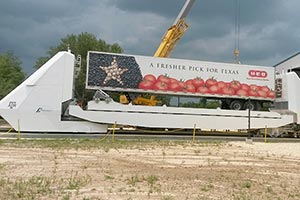Houston Port Shuttle Hailed as Potential Freight-Handling Breakthrough

A futuristic freight-hauling shuttle that can move massive cargo containers from one major shipping terminal to another at up to 70 miles per hour without using a drop of diesel or stopping at a single traffic light is set to get its real-world debut at the Port of Houston.
If all goes according to plan, the freight carrier, developed by Texas A&M Transportation Institute researcher Stephen Roop, will be used to move containers between the port's Bayport and Barbour's Cut terminals.
Powered by a 1,500-volt electrical current, the shuttle would travel the five miles between the terminals on a rail built along Texas 146.
State, port and transportation institute officials on Sept. 9 announced an agreement to move toward building the system that has been in the making for a dozen years. The agreement commits port officials to study the economic and engineering feasibility of the electric shuttle, and exactly where building one to handle port traffic makes sense.
"It has transformed from this great idea to something that is really quite real," Port of Houston Authority executive director Roger Guenther said of the freight shuttle.
The exact route, cost and who would pay for it will be part of the next few months of study. The analysis will initially focus on a shuttle moving between the two terminals at 30 mph. Roop said he's hopeful a shuttle could be operational on Houston's docks within three years, with one year of study and two years of construction.
Though officials have focused on private funding, the freight shuttle could be eligible for public money. In Houston, officials could use federal money funneled to the state related to reducing vehicle congestion to help build a shuttle, if it was shown to decrease pollution by removing diesel trucks from highways.
The shuttle's potential to speed cargo handling and reduce emissions drew accolades from state officials.
"Imagine the way these port facilities will look without those clogged roadway systems," Gov. Greg Abbott said during a news conference in Bryan announcing the shuttle's anticipated launch in Houston.
RELATED: Hyperloop technology to be studied for freight transportation
Though the shuttle is capable of carrying cargo swiftly, its development has taken a slow, methodical pace, from computer models to scale models to a full-sized system now sitting in a barn-sized building at the end of a nondescript road near Bryan's general aviation airport. "We like to think of it as Houston's newest shuttle," said Roop, who cited America's space exploration as inspiring many developments over the past six decades.
Considered by its designers as a complement to the trucking industry, the freight shuttle's development thus far has been greeted by truckers with skepticism.
"Most of them think it is pie in the sky," said John Esparza, CEO of the Texas Trucking Association. "But when you talk to a lot of them, the initial feedback is that it could really be a threat to some trucking companies' business."
Freight Shuttle Inc., a private company developed from the transportation institute research, would license the technology - the team holds 17 patents related to the shuttle - and then help companies and ports such as the one in Houston find money to build a shuttle.
Houston's port is the first partner, but not the only interested party in Texas. Officials in Fort Bend County and Freeport have cited the freight shuttle as a potential alternative connecting Port Freeport to the BNSF terminal in Rosenberg, a distance of about 50 miles. "The efficiency of it is much better," Fort Bend County Commissioner Andy Meyers said during an April meeting with Freeport and Panamanian officials.
The system is powered by linear induction, an electrical current that the on-track motors repel, forcing them along the line. With virtually no moving parts, Roop said the motors experience less wear and tear, making the $400,000 units outlast tractor-trailers that can cost that much or more.
"We'll move cargo for about 10 cents a mile in electricity," Roop predicted.
What equalizes that cost is the freight shuttle is expensive to build before it can carry any freight. Abbott said that while Houston's port is ahead with its planning, El Paso officials also are looking closely at the shuttle system for improved trade and freight movement from Mexico. With no extraordinary factors to consider, Roop's analysts have estimated a 12-mile shuttle line between El Paso and Ciudad Juarez, Mexico, would cost $12 million per mile for construction.
"We think we can shave 20% off of that," Roop said.
Whether officials can reduce building costs is uncertain, but they say what's virtually guaranteed is the electric shuttle would reduce truck trips in major metro areas if installed along clogged freight routes. Texas 146 and eastern segments of Interstate 10 in the Houston area have high truck volumes because goods are moving in and out of the petrochemical complexes and port along the Houston Ship Channel.
In heavy traffic area, redirecting freight off local freeways could solve a host of problems facing state and local officials, and the trucking industry.
"We are at a place where we are definitely needing more drivers," said Glenna Bruun, senior executive vice president of the Texas Trucking Association, based in Austin.
Though it will never replace trains or trucks for all cargo transportation, Roop said on a recent tour of his freight shuttle, it is capable of taking many trucks off the road. That could dramatically reduce maintenance costs of freeways, where hundreds of heavy trucks do far more damage than tens of thousands of automobiles and light-duty trucks.
"It's a real return on avoided costs to the (Texas Department of Transportation)," he said. "We estimated TxDOT would save $70 million if freight shuttle took 15% of the trucks off along (Interstate 35) from San Antonio to Dallas."
Governor at Freight Shuttle from TTI on Vimeo.




